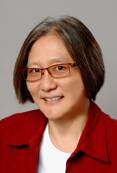Weather Events and Climate: Dr. Inez Fung speaks at Oakland’s Chabot Space and Science Center
Despite its proverbial status as a filler topic in conversation, weather events sparked a lot of commentary over the past couple years. Blizzards and canceled flights in the Northwest, massive nationwide droughts, and a few destructive storms filled headlines and grabbed people’s attention.
This month’s guest enrichment speaker, Dr. Inez Fung, discussed the difference between isolated dramatic events and overall trends in the planet’s climate during her presentation, and pointed out some mechanisms behind weather patterns. She is a Professor of Atmospheric Science in UC Berkeley’s Department of Earth and Planetary Science and the Department of Environmental Science, Policy and Management.
Dr. Fung talked about the El Nino and La Nina weather patterns at great length. She described how rising air pressure over the Indian Ocean, Indonesia and Australia, falling pressure over the Pacific Ocean, and weakening trade winds in the South Pacific lead to warm air and rain over Peru, and the spread of warm water eastward, causing drought in the western Pacific and rainfall in the normally dry eastern areas. The cycle reverses with La Nina events, bringing stronger trade winds and rain to New Guinea and the west.
Warming sea surface temperatures over the Central Equatorial Pacific suggest we may experience an El Nino event this year. This would be good for California as we need the water.
Next, she illustrated how changes in arctic air oscillation and pressure bring about unusual temperature variations over the northern hemisphere. Lower air pressure in the arctic zone allows for strong, consistent jet stream winds, keeping the frigid air locked up north. However, when the pressure increases, the jet streams weaken, allowing cold air to spread over Canada and the United States.
No one knows what causes these changes, or if they occur on any sort of predictable schedule. However, Dr. Fung pointed to this effect as a possible explanation for the streak of cold weather we experienced this winter.
Climate goes beyond occasional short-term weather events to encompass overall temperature and precipitation levels, and Dr. Fung and others are concerned about climactic trends. A 2012 statistical analysis written up by NASA researcher James Hansen uses a bell curve to represent the distribution of average summer temperatures in the Northern Hemisphere. The middle of the curve represents the majority of the average temperature values, and the ends represent the unusually hot and cold summers. The curve has shifted to the right since 1981, reflecting that what were once ‘hot’ temperatures are now normal.
Researchers are also concerned because of what studies suggest about sources of atmospheric carbon. Some carbon atoms naturally exist in a radioactive form, C14, as opposed to the normal C12. Over time, the C14 atoms decay, so CO2 produced from older sources, such as the burning of fossil fuels, will likely contain very little of that isotope, or form, of carbon atom. Right now, almost all of the increase in atmospheric carbon dioxide seems to come from older carbon atoms without much C14.
Dr. Fung closed her talk with some comments on how to mitigate and adapt to climate change. She pointed out that 15 percent of the energy we produce on Earth through all of our technologies gets lost in transmission. Given that our global energy demand is 16 to 18 terawatts per year, improving efficiency would save a large amount of energy. We can also use renewable sources of energy, but it can be challenging to scale those technologies up to meet such a large demand. So, Dr. Fung brought up carbon sequestration and geoengineering as possible ways to deal with atmospheric carbon in the meantime.

